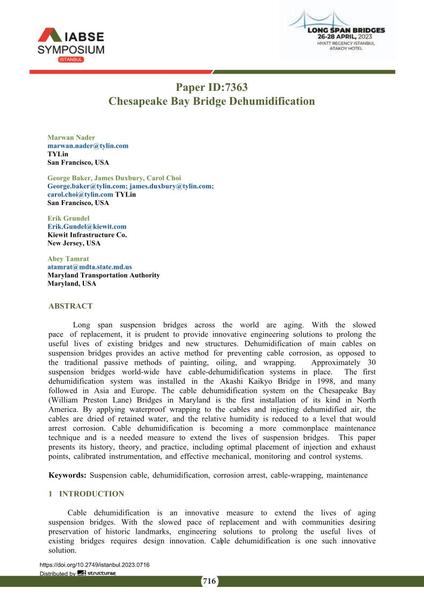Chesapeake Bay Bridge Dehumidification

|
|
|||||||||||
Bibliographic Details
| Author(s): |
Marwan Nader
(TYLin, San Francisco, USA)
George Baker (TYLin, San Francisco, USA) James Duxbury (TYLin, San Francisco, USA) Carol Choi (TYLin, San Francisco, USA) Erik Grundel (Kiewit Infrastructure Co. New Jersey, USA) Abey Tamrat (Maryland Transportation Authority Maryland, USA) |
||||
|---|---|---|---|---|---|
| Medium: | conference paper | ||||
| Language(s): | English | ||||
| Conference: | IABSE Symposium: Long Span Bridges, Istanbul, Turkey, 26-28 April 2023 | ||||
| Published in: | IABSE Symposium Istanbul 2023 | ||||
|
|||||
| Page(s): | 716-726 | ||||
| Total no. of pages: | 11 | ||||
| Year: | 2023 | ||||
| DOI: | 10.2749/istanbul.2023.0716 | ||||
| Abstract: |
Long span suspension bridges across the world are aging. With the slowed pace of replacement, it is prudent to provide innovative engineering solutions to prolong the useful lives of existing bridges and new structures. Dehumidification of main cables on suspension bridges provides an active method for preventing cable corrosion, as opposed to the traditional passive methods of painting, oiling, and wrapping. Approximately 30 suspension bridges world-wide have cable-dehumidification systems in place. The first dehumidification system was installed in the Akashi Kaikyo Bridge in 1998, and many followed in Asia and Europe. The cable dehumidification system on the Chesapeake Bay (William Preston Lane) Bridges in Maryland is the first installation of its kind in North America. By applying waterproof wrapping to the cables and injecting dehumidified air, the cables are dried of retained water, and the relative humidity is reduced to a level that would arrest corrosion. Cable dehumidification is becoming a more commonplace maintenance technique and is a needed measure to extend the lives of suspension bridges. This paper presents its history, theory, and practice, including optimal placement of injection and exhaust points, calibrated instrumentation, and effective mechanical, monitoring and control systems. |
||||
| Keywords: |
suspension cable maintenance dehumidification corrosion arrest cable-wrapping
|
||||
